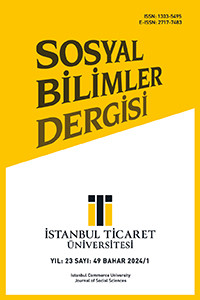Öz
Given that time series forecasts are of great importance in the financial world, the main objective of this study is to forecast Euro prices and examine the contribution of these forecasts to financial decision-making processes. Since the Euro is an important component of international trade and investment, accurate price forecasts are of strategic importance for many financial institutions and investors. In this study, we compare the performance of deep learning algorithms and classical machine learning methods for forecasting Euro prices: support vector machines (SVM), Extreme Gradient Boosting (XGBoost), long short-term memory (LSTM), and gated recurrent units (GRU). These methods represent different algorithms that are widely used in financial forecasting and give successful results. The dataset used in the study was divided into two parts: 80% training and 20% testing, and it is also indicated how each algorithm behaved during the training process and which parameters were chosen. The results are presented by comparing the performance of these algorithms, and it is found that the GRU algorithm provides better accuracy than the others. Therefore, the GRU algorithm was chosen to forecast Euro prices for the next 12 months, and the forecasting process was carried out. The results of this study are expected to provide an important perspective to financial decision-makers by comprehensively comparing the performance of deep learning and traditional approaches in Euro price forecasting. It also includes potential research avenues for future work and suggestions for the development of new methods in this area.
Anahtar Kelimeler
Time Series Forecasting Deep Learning Machine Learning Euro Exchange Rate Forecast Gated Recurrent Unit
Kaynakça
- Abar, H. (2020). Estimation of gold prices with Xgboost and Mars methods. Ekev Academy Journal, (83), 427-446.
- Akbulut, S., & Adem, K. (2023). BIST 100 prediction with the interaction of financial instruments of developing countries using deep learning and machine learning methods. Niğde Ömer Halisdemir University Journal of Engineering Sciences, 12(1), 1-1.
- Alpay, Ö. (2020). USD/TRY price forecasting using LSTM architecture. European Journal of Science and Technology, 452-456.
- Ata, O., & Erbudak, A. E. (2022), Exchange rate forecasting application with data mining and machine learning. Fırat University Journal of Engineering Sciences, 34(2), 553-563.
- Bağcı, B. (2020). Increasing the forecasting power of moving averages and exponential smoothing methods: forecasting the exchange rate in Turkey. Turkuaz International Journal of Socio-Economic Strategic Research, 2(1), 1-12.
- Bircan, H., & Karagöz, Y. (2003). An application on monthly exchange rate forecasting with Box-Jenkins models. Kocaeli University Journal of Social Sciences, (6), 49-62.
- Central Bank of the Republic of Turkey, https://evds2.tcmb.gov.tr/index.php?/evds/serieMarket Access Date: 04.10.2023.
- Cho K., Van Merrienboer B., Gulcehre C., Bahdanau, D., Bougares, F., Schwenk, H. & Bengio, Y. (2014). Learning phrase representations using RNN encoder-decoder for statistical machine translation, arXiv preprint, arXiv:1406.1078, 2014.
Derin Öğrenme Algoritmaları ve Makine Öğrenmesi Algoritmaları Kullanarak Euro Döviz Kurunun Tahmin Edilmesi
Öz
Zaman serisi tahminlerinin finans dünyasında büyük önem taşıdığı düşünüldüğünde, bu çalışmanın temel amacı Euro fiyatlarının tahmin edilmesi ve bu tahminlerin finansal karar alma süreçlerine katkısının incelenmesidir. Euro, uluslararası ticaret ve yatırımın önemli bir bileşeni olduğu için doğru fiyat tahminleri, birçok finansal kurum ve yatırımcı için stratejik öneme sahiptir. Bu çalışmada, Euro fiyatlarını tahmin etmek için derin öğrenme algoritmaları ve klasik makine öğrenmesi yöntemlerinin performansları karşılaştırılmıştır: Destek Vektör Makineleri (SVM), Aşırı Gradyan Artırma (XGBoost), Uzun Kısa Vadeli Hafıza (LSTM) ve Geçitli Tekrarlayan Birim (GRU). Bu yöntemler, finansal tahminlerde yaygın olarak kullanılan ve başarılı sonuçlar veren farklı algoritmaları temsil etmektedir. Çalışmada kullanılan veri seti, %80 eğitim ve %20 test olmak üzere ikiye bölünmüş ve her bir algoritmanın eğitim süreci boyunca nasıl davrandığını ve hangi parametrelerin seçildiği de belirtilmiştir. Sonuçlar, bu algoritmaların performansları karşılaştırılarak sunulmuş ve GRU algoritmasının diğerlerine göre daha iyi bir doğruluk sağladığı görülmüştür. Bu nedenle, gelecek 12 aylık Euro fiyatlarını tahmin etmek için GRU algoritması seçilmiş ve tahmin işlemi gerçekleştirilmiştir. Bu çalışmanın sonuçlarının, Euro fiyat tahmininde derin öğrenme ve geleneksel yaklaşımların performanslarını kapsamlı bir şekilde karşılaştırarak finansal karar alıcılara önemli bir bakış açısı sunacağı düşünülmektedir. Ayrıca, gelecek çalışmalar için potansiyel araştırma yollarını ve bu alanda yeni yöntemlerin geliştirilmesine yönelik önerileri de içermektedir.
Anahtar Kelimeler
Zaman Serisi Tahmini Derin Öğrenme Makine Öğrenimi Euro Döviz Kuru Tahmini Geçitli Tekrarlayan Birim
Etik Beyan
Bu çalışma için Etik kurul iznine gerek duyulmamıştır.
Kaynakça
- Abar, H. (2020). Estimation of gold prices with Xgboost and Mars methods. Ekev Academy Journal, (83), 427-446.
- Akbulut, S., & Adem, K. (2023). BIST 100 prediction with the interaction of financial instruments of developing countries using deep learning and machine learning methods. Niğde Ömer Halisdemir University Journal of Engineering Sciences, 12(1), 1-1.
- Alpay, Ö. (2020). USD/TRY price forecasting using LSTM architecture. European Journal of Science and Technology, 452-456.
- Ata, O., & Erbudak, A. E. (2022), Exchange rate forecasting application with data mining and machine learning. Fırat University Journal of Engineering Sciences, 34(2), 553-563.
- Bağcı, B. (2020). Increasing the forecasting power of moving averages and exponential smoothing methods: forecasting the exchange rate in Turkey. Turkuaz International Journal of Socio-Economic Strategic Research, 2(1), 1-12.
- Bircan, H., & Karagöz, Y. (2003). An application on monthly exchange rate forecasting with Box-Jenkins models. Kocaeli University Journal of Social Sciences, (6), 49-62.
- Central Bank of the Republic of Turkey, https://evds2.tcmb.gov.tr/index.php?/evds/serieMarket Access Date: 04.10.2023.
- Cho K., Van Merrienboer B., Gulcehre C., Bahdanau, D., Bougares, F., Schwenk, H. & Bengio, Y. (2014). Learning phrase representations using RNN encoder-decoder for statistical machine translation, arXiv preprint, arXiv:1406.1078, 2014.
Ayrıntılar
| Birincil Dil | İngilizce |
|---|---|
| Konular | Ekonometrik ve İstatistiksel Yöntemler, Finansal Ekonometri |
| Bölüm | Araştırma Makalesi |
| Yazarlar | |
| Yayımlanma Tarihi | 30 Haziran 2024 |
| Gönderilme Tarihi | 21 Ekim 2023 |
| Kabul Tarihi | 19 Mart 2024 |
| Yayımlandığı Sayı | Yıl 2024 Cilt: 23 Sayı: 49 |



